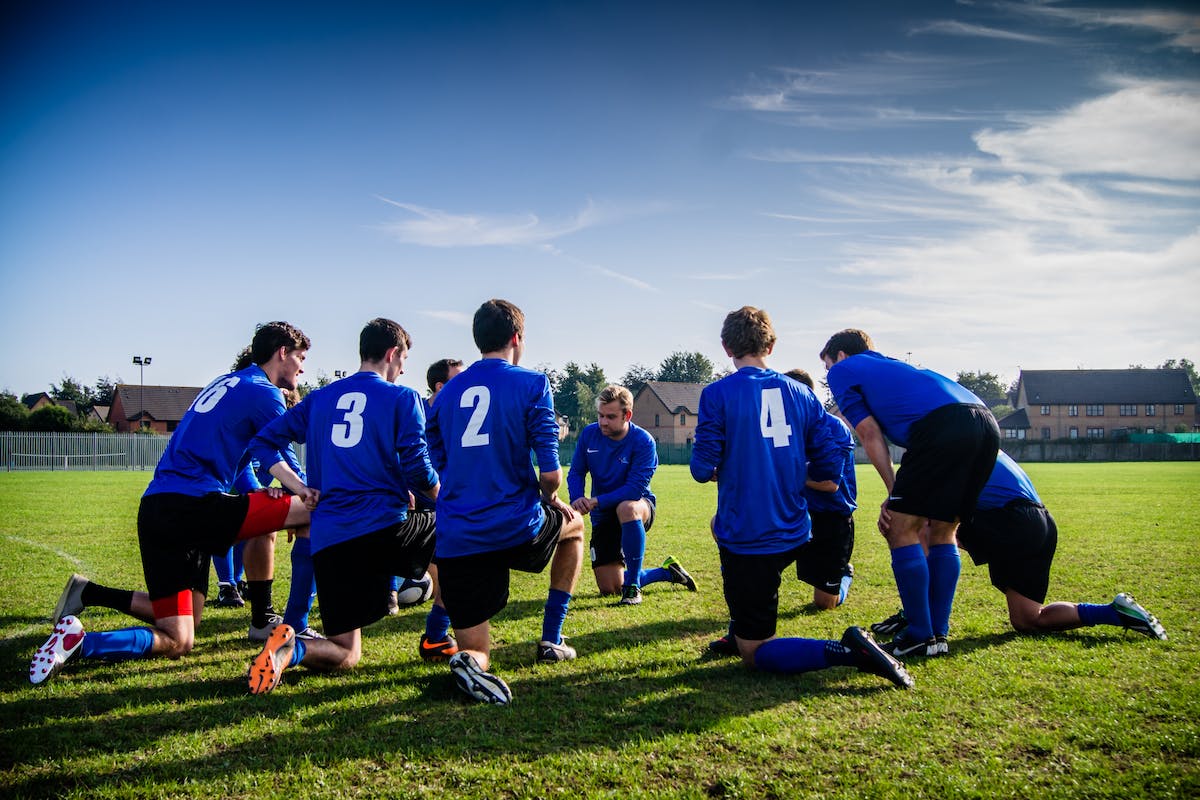Sports injuries are common and can be physically and mentally demanding. Preventive measures are essential for reducing injury risk and maintaining optimal performance. Key aspects include understanding sports injuries, performing correct warm-ups and cool-downs, prioritizing nutrition, hydration, and proper gear. Mental health and regular health screenings are integral to prevention strategies. The benefits of cross-training also play a significant role. These elements work together in the sports world to create a healthier, safer environment.
Understanding Sports-Related Injuries
Understanding sports-related injuries is pivotal for prevention. The key elements are their nature, causes, and occurrence mechanisms. This knowledge is obtainable through Injury Statistics and Recovery Timeframes analysis.
Injury Statistics show strains and sprains as prevalent sports injuries. They result from overuse, unsuitable training, lack of conditioning, or insufficient warm-up. Recognizing these causes informs prevention strategies.
Recovery Timeframes offer insights into injury severity and recovery duration. For example, a minor strain necessitates a week’s rest, while a severe sprain requires months to heal. Comprehending these timeframes aids in planning training schedules and setting realistic recovery expectations.
The Importance of Proper Warm-ups
Proper warm-ups, a vital preventive measure against sports-related injuries, prime the body for physical exertion, reducing strains and sprains risk. They combine light aerobic movements and stretching exercises, preparing muscles, circulatory and respiratory systems for intensive physical activities. Warm-ups also enhance athletes’ mental readiness, improving focus, reaction time, and coordination. Environmental conditions, including temperature, humidity, and altitude, significantly affect warm-up effectiveness. In cold climates, extended warm-up sessions optimize muscle elasticity. Conversely, high humidity and altitude necessitate routine adjustments to avoid respiratory system stress.
Techniques for Effective Cool-Downs
Post-workout, effective cool-downs are crucial for athletes, aiding recovery and injury prevention. This section highlights essential cool-down exercises, their benefits, and their role in averting injuries post-workout. The adoption of these techniques can significantly boost athletic performance and longevity.
Essential Cool-Down Exercises
Why is a cool-down routine crucial for athletes? A well-structured cool-down routine facilitates quick transition from high-intensity activity to rest, reducing strenuous training impacts. Including diverse exercises in the cool-down enhances recovery methods, allowing the body to decrease heart rate and regain normal breathing. Activities like gentle jogging, walking, or cycling are effective cool-down exercises. Stretching is vital in preventing muscle stiffness, speeding recovery, and enhancing flexibility. Resistance band exercises, beneficial for injury prevention, are another good inclusion. A comprehensive cool-down routine aids physical recovery and mental relaxation, preparing athletes for future training sessions.
Benefits of Proper Cool-Down
Cool-down offers numerous benefits to athletes, impacting their performance and recovery. It enhances flexibility, mobility, reduces muscle soreness, accelerates recovery, lowers injury risk, and facilitates psychological recovery. Each athlete’s unique characteristics determine their cool-down needs, requiring customization considering workout intensity, fitness level, and sport-specific demands. Thus, a proper cool-down positively affects both physical and mental aspects of athletic performance.
Preventing Injury Post-Workout
Posture correction is key in injury prevention post-workout; it promotes proper body alignment during cool-down, and aids muscle relaxation and recovery. Massages, integrated into post-workout routines, relax tense muscles, enhance circulation, expedite recovery, and remove lactic acid build-up to prevent muscle soreness. These techniques are essential for athlete’s post-exercise injury prevention.
Nutrition: Fueling Your Performance
Athlete performance hinges on proper nutrition and hydration. Understanding sports nutrition fundamentals enables optimized meal plan creation, tailored to individual training and performance requirements. This enhances efficiency and endurance. Optimal hydration, crucial for performance and recovery, must be maintained.
Understanding Sports Nutrition Basics
Sports nutrition, a key to peak athletic performance, involves optimal dietary intake for physical activity enhancement. It includes balanced diet, hydration, dietary supplements, and responsible use of performance-enhancing substances. A balanced diet comprises carbohydrates, proteins, and fats, providing necessary energy for physical activities. Regular fluid intake prevents dehydration and maintains performance. Dietary supplements can complement nutrition gaps, but cannot replace balanced diet. Performance-enhancing substances, used responsibly and ethically, can boost performance.
Optimized Meal Plans
Sports nutrition is key to an athlete’s performance, with optimized meal plans being critical. Such plans should include balanced carbohydrates, proteins, fats, and supplements. Supplements, used wisely and under a nutritionist’s guidance, can bridge nutritional deficits, aid muscle recovery, and boost energy. The connection between an athlete’s diet and sleep is also crucial. Nutrient-rich food can enhance sleep quality, essential for body recovery and performance. Thus, an optimized meal plan impacts not just eating habits but also overall athlete well-being and performance.
Hydration’s Role in Performance
In athletic performance, optimal hydration is critical for endurance, strength, and recovery. Misunderstandings, often stemming from hydration myths, can obscure effective hydration methods.
- Water vs. Sports Drinks: Water is vital for hydration, while sports drinks replenish electrolytes lost during high-intensity exercises.
- Dehydration: Beyond hampering performance, dehydration can induce serious health complications.
- Over-hydration: This can result in hyponatremia, a harmful condition.
- Individual Needs: Hydration needs can differ greatly among athletes.
A comprehensive grasp of hydration science can guide athletes towards effective hydration tactics, improving performance and health.
Hydration and Athletic Performance
Hydration, a crucial yet often underrated factor, significantly influences an athlete’s performance and health. This involves not only water intake but also maintaining electrolyte balance. However, many athletes are misinformed due to prevalent hydration myths.
Contrary to the myth that thirst is an unreliable hydration indicator, it can serve as a dependable signal during intense physical activities. Athletes should also check urine color, aiming for a light, straw-like hue to confirm optimal hydration.
Overhydration, despite the myth of continuous drinking to prevent dehydration, can cause hyponatremia, a condition marked by low blood sodium levels. The goal is to achieve balanced hydration, avoiding excessive water intake.
Electrolyte balance, which includes minerals like sodium, potassium, and magnesium, is vital. These elements regulate nerve and muscle function, balance blood acidity and pressure, and repair damaged tissue. Athletes should, therefore, ensure a balanced diet and use suitable sports drinks when needed.
The Role of Rest in Recovery
Rest is vital for an athlete’s recovery, enhancing their performance by restoring energy, repairing muscle tissue, and strengthening memory and learning connections. Emphasizing the importance of sleep, it directly influences physical performance and mental focus. Insufficient rest can result in mental fatigue, decreased alertness, and poor decision-making.
Four key rest benefits include:
- Muscle Repair: Rest initiates tissue repair and cell growth, facilitating muscle recovery.
- Energy Restoration: Energy reserves, depleted during exertion, are replenished during rest.
- Mental Freshness: Adequate rest mitigates mental fatigue, boosting focus and alertness.
- Memory Consolidation: Sleep aids in assimilating new training skills and strategies.
Strength Training for Injury Prevention
Rest is a foundation for injury prevention in athletes, but strength training offers improved muscular stability and resilience. This approach can lessen injury risks like muscle imbalances, mobility limits, and movement issues. Strengthening muscles, tissues, and joints prepares athletes for their sport’s physical demands, reducing injury chances and aiding faster recovery.
Strength training should be specialized for each sport, focusing on both major and minor muscle groups. Athletes should combine resistance exercises for strength building and flexibility exercises for joint mobility and muscle elasticity. Exercises that enhance balance and coordination can also help to prevent falls and unsteady movement injuries.
It’s essential for athletes to heed their body’s reaction to training. Over-training can lead to injuries and lengthen recovery time. Athletes should integrate rest days and adjust their training regimen based on their body’s response to avoid injuries and optimize performance.
The Impact of Flexibility Exercises
Flexibility exercises enhance athletic performance and injury prevention. They extend joint range, boost muscle strength and endurance, yielding flexibility benefits. However, stretching misconceptions persist among athletes. Contrary to popular belief, pre-workout static stretching may hinder performance.
Four crucial points about flexibility exercises include:
- Warm-up routines should incorporate dynamic stretching, gradually increasing reach and movement speed.
- Post-exercise is optimal for static stretching, holding a muscle at its furthest point.
- Regular flexibility training boosts performance by enhancing speed, agility, and power.
- All major muscle groups should undergo flexibility exercises for balanced strength and flexibility.
Acknowledging the impact of flexibility exercises helps athletes optimize potential and reduce injury risk.
Importance of Wearing Appropriate Gear
Flexibility exercise importance is parallel to using suitable athletic gear for injury prevention and performance enhancement. Protective equipment provides safety, stability, and support to athletes. Selection and maintenance of gear matter. Regular equipment inspection is crucial for detecting wear, tear, or damage, ensuring reliability and effectiveness. Addressing malfunctions promptly prevents safety or performance compromises. Protective gear varies with sport type, including helmets, shin guards, mouth guards, elbow pads, eye guards, and protective cups. Each piece shields the body’s vulnerable areas from potential injury.
Mental Health and Injury Prevention
Mental health significantly impacts injury prevention and performance in athletes. It involves emotional resilience and mental toughness, essential for managing competition pressure, overcoming obstacles, and reducing injury risk from stress or distraction.
This health maintenance includes:
- Mental Conditioning: Like physical training, athletes should regularly practice mindfulness and visualization techniques.
- Building Emotional Resilience: It requires fostering a positive mindset and developing stress and adversity coping mechanisms.
- Fostering Mental Toughness: Athletes need to embrace challenges, persist despite setbacks, and view effort as a path to mastery.
- Providing Mental Health Resources: Teams should ensure access to sports psychology specialists like psychologists or counselors.
Regular Health Check-ups and Screenings
Regular health screenings and check-ups are crucial for athletes. They enable early identification and prompt management of potential performance-hindering conditions. These preventative measures maintain athletes’ optimal health and performance.
Importance of Screenings
Screenings hold vital significance in athletes’ preventive care routine, despite cost and accessibility concerns. They serve four primary functions:
- Early Detection: Screenings facilitate early detection of potential health issues, making treatment easier and cost-effective.
- Prevention: Screenings identify chronic disease risk factors, enabling preventive actions.
- Monitoring: Regular screenings assist in controlling existing conditions.
- Peace of Mind: Knowledge of health status reduces anxiety, enhancing athletes’ performance focus.
In essence, screenings are an indispensable part of an athlete’s health regimen.
Scheduling Regular Check-ups
Regular health screenings and check-ups are crucial for athletes’ preventive care, enabling early detection and prevention of potential health issues. Personalized check-up frequency is essential, based on the athlete’s age, sport, training intensity, and medical history. A minimum of two wellness check-ups per year is advisable, with more for high-intensity sports athletes. Vaccinations are significant in preventive care, protecting athletes and their community from illnesses. Hence, integrating regular vaccinations into the athlete’s healthcare plan is advisable.
The Benefits of Cross-Training
Cross-training benefits athletes by enhancing overall fitness, reducing injury risk, and boosting performance in their primary sport.
- Diverse Exercises: Cross-training incorporates varied exercises, averting monotony and fostering balanced fitness.
- Muscle Strength and Flexibility: Varied workouts build strength in different muscle groups, promoting balance, flexibility, and injury prevention.
- Recovery Enhancement: Cross-training facilitates active recovery, allowing rest for overworked muscles while engaging others.
- Performance Boost: Athletes can improve performance in their primary sport through skills and abilities reinforced by cross-training.
Frequently Asked Questions
How Does Age Affect an Athlete’s Ability to Prevent Injuries?
Athlete’s age influences injury prevention. Aging athletes may need specific diet and training for optimal health and injury risk reduction.
Does the Type of Sport Played Influence the Necessary Preventive Measures?
Sport type dictates preventive measures. Each sport necessitates particular nutrition and mental preparations to reduce injury risk, enhance performance, and maintain athlete well-being.
Can Previous Injuries Increase the Risk of Future Injuries, Even With Preventive Measures in Place?
Indeed, prior injuries elevate future injury risk, even with preventive measures. Personalized rehabilitation and targeted training are crucial to strengthen injured areas.
How Does the Climate or Weather Condition Impact an Athlete’s Injury Prevention Strategies?
Climate impacts athlete injury prevention, necessitating weather-specific adaptations. Alterations in training schedules are crucial adaptations. Hydration strategies prevent heat-related illnesses and ensure optimal performance in extreme temperatures.
Can Genetic Factors Play a Role in the Likelihood of Sports-Related Injuries?
Indeed, genetics play a role in sports-related injuries. They influence factors such as injury recovery rate and nutritional response, both essential for minimizing injury risk and facilitating effective healing post-injury.



